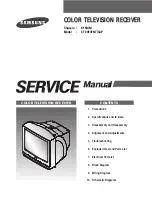
UHF RECEIVER
3-10
July 2000
Part No. 001-2000-720
5. Adjust C249 for peak DC voltage at TP201.
6. Reset the signal generator to the tune-up frequency.
7. Set the signal generator to 100
µ
V into the receiver
with a 1 kHz tone at
±
1.5 kHz deviation.
(1000
µ
V at the generator with 20 dB pad gives
100
µ
V at the receive antenna.)
8. Tune Z215 for 2V
±
0.05V at U203, pin 9.
9. Tune R253 for 387 mV RMS,
±
5 mV RMS, at
TP202.
10.Adjust R248 for 2V ±0.05V at TP202.
11. Connect a distortion analyzer to TP202.
12.Tune L211, L213, L214 and L216 for minimum
distortion <5%, (typically <3%).
13.Repeat Step 12 then Steps 8, 9 and 10.
3.3.7 AUDIO DISTORTION
1. On the Interface Board, plug a 16 ohm load at J204.
2. Connect a distortion analyzer to the 16 ohm load.
3. On the Interface Board, measure the distortion of the
receive audio at J204 with the local volume control
set to 2.8V RMS.
4. The reading shall be less than 3%.
(Typically less than 1%.).
3.4 FULL CVR TEST
1. Select TEST - FULL RPTR/STATION/CVR and
press Enter.
NOTE: All audio generators and audio voltmeters are
unbalanced unless specifically stated otherwise.
3.4.1 VOLTAGE MEASUREMENTS
1. Disconnect the receiver-to-interface cable
(20-pin) from J201 of the Interface board.
2. Apply power to the Interface board.
3. Measure the voltages at the following pins.
U221, pin 1
+12V DC
±
0.4V
U223, pin 2
+9V DC
±
0.4V
U224, pin 2
+5V DC
±
0.2V
U204, pin 7
+1.25V DC
±
0.06V
Junction of L202/C279 -5V DC
±
0.4V
4. Apply power to the Receiver by plugging the 20-pin
cable from the Interface Board into J201 (see
Figure 3-28
).
3.4.2 RECEIVER FREQUENCY CHECK
1. Check the receiver injection frequency with a
"sniffer" pickup loop, or RF probe and a suitable
frequency counter placed near TP102.
2. TCXO Adjustment
Set Y401 (TCXO) for the Injection Frequency
±
90 Hz at 12.5 kHz or ±50 Hz at 25 kHz
(Inj Freq = chnl freq + 52.95 MHz).
Receiver Audio Distortion Measurement
1. Adjust the RF generator for 100
µ
V into the receiver
with a 1 kHz tone at
±
3 kHz deviation.
2. Adjust R207 for 0 dBm (775 mV RMS) at J210.
3. Connect a 16 ohm load and distortion analyzer to
J204 of the Interface Board.
4. Adjust R262 for 2.8V RMS and measure the distor-
tion. Distortion should be < 3%.
Receiver Hum and Noise Measurement
1. Adjust the RF generator for 100
µ
V into the receiver
with a 1 kHz tone at
±
3 kHz.
2. Connect a 16 ohm load and distortion analyzer to
J204 of the Interface Board.
3. Adjust R262 for 2.8V RMS.
4. Remove modulation from the RF generator.
The measured level must be
≤
-45 dB.
Summary of Contents for CONVENTIONAL VOTING RECEIVER
Page 2: ... 2 February 1996 Part No 001 3039 505 ...
Page 4: ... 4 February 1996 Part No 001 3039 505 ...
Page 16: ...INTRODUCTION 1 6 July 2000 Part No 001 2000 720 ...
Page 42: ...2 26 July 2000 Part No 001 2000 720 ...
Page 64: ...UHF RECEIVER 3 22 July 2000 Part No 001 2000 720 ...
Page 68: ...3 36 July 2000 Part No 001 2000 720 ...
Page 86: ...800 MHz RECEIVER 4 18 July 2000 Part No 001 2000 720 ...
Page 90: ...4 22 July 2000 Part No 001 2000 720 ...
Page 112: ...5 22 July 2000 Part No 001 2000 720 ...
Page 118: ...INTERFACE BOARD 6 6 July 2000 Part No 001 2000 720 ...
Page 121: ...INTERFACE BOARD 6 9 July 2000 Part No 001 2000 720 ...
Page 124: ...INTERFACE BOARD 6 12 July 2000 Part No 001 2000 720 ...
Page 128: ...6 12 July 2000 Part No 001 2000 720 ...
Page 130: ...6 2 July 2000 Part No 001 2000 720 ...
Page 134: ...POWER SUPPLIES 8 4 July 2000 Part No 001 2000 720 ...
Page 146: ...800 MHz RECEIVER CHANNEL FREQUENCY CHART A 12 July 2000 Part No 001 2000 720 ...
















































